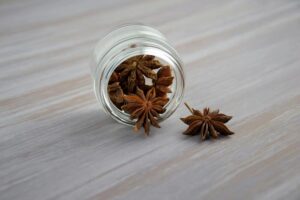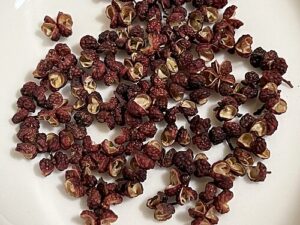Asia has gifted the world some of the most irresistible flavors ever created, and if Asian cuisine had its own talent show, spices would win every single season. These aren’t just ingredients they’re personalities. They heal, they transform, they add drama, and sometimes they stain your shirt for life (looking at you, turmeric). From the superhero spice that electrifies your mouth to the glamorous queen that makes desserts smell like a poem, Asian spices have stories, history, and plenty of attitude. So sit back, grab your chopsticks, and meet the five spices that make Asia’s food unforgettable and your tastebuds extremely happy.
Turmeric – The Golden Drama Queen of Asian Spices
Turmeric is the Beyoncé of the Asian spice world. The moment it enters the kitchen, everything suddenly becomes golden, glamorous, and impossible to ignore. Add one pinch to your food and boom your rice is runway-ready, your curry looks like it’s posing for a magazine cover, and your soup instantly wins a beauty contest.  But turmeric isn’t just a pretty face. Oh no, this spice has been flexing its health superpowers long before “wellness influencers” existed. Ancient healers used it for digestion, inflammation, glowing skin basically everything except fixing heartbreak (we’re still waiting). In India and Southeast Asia, turmeric is found in curries, rice dishes, marinades, healing teas, and even face masks. It’s like that friend who somehow does every hobby perfectly and still looks amazing. And yes, it may stain your clothes forever, but that’s just turmeric marking you as someone fabulous. Considering all its benefits, honestly it’s worth the laundry struggle.
But turmeric isn’t just a pretty face. Oh no, this spice has been flexing its health superpowers long before “wellness influencers” existed. Ancient healers used it for digestion, inflammation, glowing skin basically everything except fixing heartbreak (we’re still waiting). In India and Southeast Asia, turmeric is found in curries, rice dishes, marinades, healing teas, and even face masks. It’s like that friend who somehow does every hobby perfectly and still looks amazing. And yes, it may stain your clothes forever, but that’s just turmeric marking you as someone fabulous. Considering all its benefits, honestly it’s worth the laundry struggle.
Ginger – The Spice That Slaps You Awake
If spices had personalities, ginger would be that witty friend who enters a room and instantly wakes everybody up. Sharp, bold, and slightly spicy, ginger doesn’t whisper flavor it slaps it into your tastebuds. It’s in everything: Chinese stir-fries, Japanese pickles, Indian curries, Korean teas, Southeast Asian desserts… and if you’re feeling queasy, Asian grandmothers everywhere will instantly hand you ginger tea before you can even finish saying “I feel sick.” Fresh, powdered, dried, pickled, candied ginger has more outfit changes than a K-pop star on tour. Sushi wouldn’t feel complete without that pink ginger on the side, bringing mouth-refreshing realness between bites. And don’t get us started on ginger’s medicinal resume: digestion booster, cold fighter, anti-nausea champion, and body warmer in the winter. Basically, ginger is both your flavor trainer and your personal wellness coach. It shows up, shakes things up, and makes sure you feel alive while you eat.
It’s in everything: Chinese stir-fries, Japanese pickles, Indian curries, Korean teas, Southeast Asian desserts… and if you’re feeling queasy, Asian grandmothers everywhere will instantly hand you ginger tea before you can even finish saying “I feel sick.” Fresh, powdered, dried, pickled, candied ginger has more outfit changes than a K-pop star on tour. Sushi wouldn’t feel complete without that pink ginger on the side, bringing mouth-refreshing realness between bites. And don’t get us started on ginger’s medicinal resume: digestion booster, cold fighter, anti-nausea champion, and body warmer in the winter. Basically, ginger is both your flavor trainer and your personal wellness coach. It shows up, shakes things up, and makes sure you feel alive while you eat.
Star Anise – The Spice That Looks Like It Belongs in a Jewelry Store
Star anise is the only spice in the Asian pantry that looks like it could be sold in a luxury boutique. Beautiful, symmetrical, and shaped like an actual star, it could easily be worn as earrings if it didn’t make everything around it taste like elegant licorice. In Chinese and Vietnamese cooking, star anise is a big deal. It gives pho that unforgettable warm aroma and creates the deep flavor magic in braised pork dishes, hot pots, and slow-cooked soups. It often hangs out with cinnamon, ginger, and soy sauce, forming an elite flavor squad. But don’t let its classy exterior fool you star anise is also a secret health agent. For centuries, people used it for coughs, colds, digestion and today, scientists even extract compounds from it for antiviral medicine. So yes, star anise is beautiful, talented, AND medically useful. If spices ever had a beauty pageant, this one would definitely win “Best in Show.”
In Chinese and Vietnamese cooking, star anise is a big deal. It gives pho that unforgettable warm aroma and creates the deep flavor magic in braised pork dishes, hot pots, and slow-cooked soups. It often hangs out with cinnamon, ginger, and soy sauce, forming an elite flavor squad. But don’t let its classy exterior fool you star anise is also a secret health agent. For centuries, people used it for coughs, colds, digestion and today, scientists even extract compounds from it for antiviral medicine. So yes, star anise is beautiful, talented, AND medically useful. If spices ever had a beauty pageant, this one would definitely win “Best in Show.”
Cardamom – The Fancy, Sweet, Aromatic Queen
Cardamom is the royal diva of Asian spices. If turmeric is Beyoncé, then cardamom is totally Mariah Carey glamorous, expensive, and never arriving without a legendary entrance. Open a pod and you’ll get a scent so heavenly that even your spoon feels underdressed. South Asia loves cardamom like no other. It dances through biryanis, perfumes chai tea, elevates desserts like kheer, and turns everyday dishes into romantic poetry. In Southeast Asia, Thai soups and curries also adore its floral magic. There are two types: green cardamom (delicate, elegant, like a princess entering ballroom doors) and black cardamom (deep, smoky, the mysterious rebel in leather boots). Beyond flavor, cardamom has serious health street cred ancient healers used it for digestion, detox, fresh breath, and calming the body. Honestly, it’s the spice that walks into your life, smells amazing, improves your health, and leaves you wondering why regular mint gum even exists.
In Southeast Asia, Thai soups and curries also adore its floral magic. There are two types: green cardamom (delicate, elegant, like a princess entering ballroom doors) and black cardamom (deep, smoky, the mysterious rebel in leather boots). Beyond flavor, cardamom has serious health street cred ancient healers used it for digestion, detox, fresh breath, and calming the body. Honestly, it’s the spice that walks into your life, smells amazing, improves your health, and leaves you wondering why regular mint gum even exists.
Sichuan Pepper – The Spice That Shocks Your Tongue
Sichuan pepper is not here to play. It doesn’t just season food it electrocutes your tastebuds in the best way possible. Bite into it, and suddenly your tongue starts tingling, buzzing, and questioning all its life choices.  This sensation has a name: “málà” the famous numbing-and-spicy combo that defines Sichuan cuisine. Hot pots, mapo tofu, dan dan noodles… none of them would be the same without Sichuan pepper saying, “Let’s make this meal unforgettable.” Unlike regular pepper or chili, it doesn’t burn it tingles like carbonated fireworks. People love it, fear it, and crave it all at the same time. Traditional Chinese medicine also gives it full respect, using it to boost circulation, warm the body, and help digestion. It’s basically culinary caffeine once it kicks in, your palate wakes up and goes, “WHAT IS HAPPENING?!” And that’s the whole point. Sichuan pepper proves that food isn’t just flavor it’s an experience.
This sensation has a name: “málà” the famous numbing-and-spicy combo that defines Sichuan cuisine. Hot pots, mapo tofu, dan dan noodles… none of them would be the same without Sichuan pepper saying, “Let’s make this meal unforgettable.” Unlike regular pepper or chili, it doesn’t burn it tingles like carbonated fireworks. People love it, fear it, and crave it all at the same time. Traditional Chinese medicine also gives it full respect, using it to boost circulation, warm the body, and help digestion. It’s basically culinary caffeine once it kicks in, your palate wakes up and goes, “WHAT IS HAPPENING?!” And that’s the whole point. Sichuan pepper proves that food isn’t just flavor it’s an experience.
Spices are the heart of Asian cooking bold, ancient, flavorful, and dramatic in all the best ways. Whether you like comforting warmth or electrifying sensations, there’s a spice on this list ready to change your meal (and maybe your life). Happy cooking!



